Introduction
There are many problems when learning a new language, including vocabulary and grammar. But one particular problem in English is the complications of the spelling system and how the vowel letters should sound when spoken. This is because many languages have been absorbed into English and their effect on English spelling and pronunciation has changed over the years. Because most people learn to read very early in their lives, the way the letters are pronounced became automatic for them long ago. Thus, learning to read in a new language using the same letters, but with different sounds, can be frustrating. The English letter/sound system is so complicated that it is hard even for native speakers to learn. Speakers of Spanish have an easier time learning to read their own language because the connection between the letters and their sounds is simpler. For this reason, it is useful to teach English learners simple ways to guess how English spelling should be pronounced. In this article, I will first present six conclusions based upon research, which help explain why some English vowels must be said clearly but others must not. These conclusions will be followed by eight classroom implications. They will include an explanation of the two main specifically English sounds to use for the vowel letters, followed by two simple spelling rules to help learners guess which of the main vowel sounds is appropriate.
Six Research Conclusions
A number of researchers have suggested the following six conclusions concerning spoken English.
1. Concentrating on individual sounds (such as the difference between ship/sheep) is not an efficient use of time (Walker, 1999).
2. The music (melody and rhythm) of the spoken language is central to speaking clearly in English (Derwing & Munro, 2005).
3. For Spanish speakers, a command of English rhythm is a top priority (Chela de Rodriguez, 1991).
4. Stress, with its effect on timing, helps the listener to notice the most important words (Hahn, 2004).
5. Because of the effect of stress, many unstressed vowels are not clear (Patel, 2008).
6. It is possible to reliably guess which vowel sound to choose for a particular spelling (Carney, 1994).
My Conclusions from the Research
In this section I will provide the reader with my conclusions based on research. Musical signals (prosody, suprasegmentals) help the listener to notice the most important words and also to know which vowels must be clear and which not clear. The first part of language that we all learned as infants (starting even before birth) is the rhythm of our mother’s language (Werker & Gervain, 2013). This rhythm is a basic part of our identity: who we are and what group we belong to. Therefore, speaking in a “foreign” rhythm may be uncomfortable. Such feelings are not likely to be recognized consciously, but may nonetheless interfere with learning the new way of speaking. Students and teachers need to be encouraged not to think of subtracting an accent, but adding a new one. This is known as code-switching. Students should be helped to view English pronunciation like a jacket that you can put on and take off, depending on who you are speaking with.
Eight Classroom Implications of the Research
In this section I offer eight classroom implications based upon research and activities which can be used in the classroom.
1. English stress is not the same as Spanish stress
To understand why English vowels are often not pronounced clearly, it is helpful to understand the difference in the way English uses stress. Spanish uses contrastive stress marks to show different meanings between words. For instance, the words canto and cantó mean something different. This meaning difference is hard to learn for English speakers who are studying Spanish because stress is used for a different purpose in English. Spanish mostly uses grammar or the order of the words to call attention to the main point, but English uses stress for this purpose. Here are examples of the difference between the way English and Spanish make clear what is most important in the sentence, the emphasis. Capital letters or bold type or underlining can be used to indicate a stressed syllable. The following are some examples.
a. The bear was HUNgry. (He wanted food)
b. El oso tenía hambre.
a. The bear WAS hungry. (He isn’t hungry anymore)
b: El oso sí que tenía hambre.
a. No, it’s HIS fault. (It is not mine)
b. Al contrario, la culpa la tiene él.
In a photograph, if something is in focus, it is very clear. But if there is no special focus, then nothing stands out. In a similar way, English uses contrastive stress in a sentence to make clear which word is the focus of meaning.
Figure 1 shows the way the English stress system works. The foundation of the pyramid is the thought group (a short sentence, clause or phrase). The most important word in a thought group is the focus word. The peak syllable in this word is stressed. The vowel in this syllable is the peak of information.
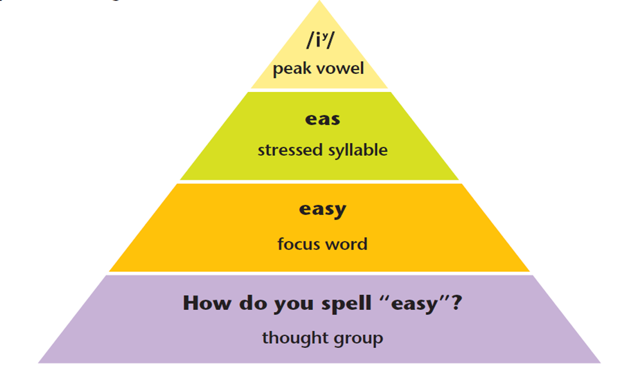
Fig. 1. The English stress system pyramid (Gilbert, 2012a, p. x).
2. The main signal of English stress is lengthening the vowel sound
English uses an irregular length of syllables, making some vowels extra-long and other vowels extra short. This produces the characteristic rhythm of English. Patel (2008) mentions that stressed vowels in English are about 60% longer than the same vowels in unstressed syllable, but Spanish syllables are all roughly the same length. This is why Spanish-speaking students should be encouraged to think of this rhythm as a useful tool. The added rhythm pattern is a way to “switch codes” depending on who is listening. Below are a few ways to practice this variable length.
Task A. You can help boost students’ mastery of English rhythm by giving them big rubber bands to stretch while they say the lengthened, stressed syllable when they are practicing the word. This is a kinesthetic way to practice and it is fun. But, of course, it may not be such a good idea for junior high school age!

The following are some sample words to practice with:
CONtrast computer eLECtric arRANGEment ASpirin
aGREEment CANada SANDwich eleMENtary a LEMon tree
Task B. Ask students to write the above words on paper or on the board, making the stressed vowel letters extra wide such as Figure 2. Then have them read these words out loud together. Reciting together helps people keep in the rhythm, like singing in a chorus.
Task C. Have students walk around the room in a circle, saying either these same words or the following short sentences, making an extra-long step when saying the stressed syllable. This is a good change of pace from sitting, and requires that the students pay attention to how they are speaking.
We need CONtrast. We need a comPUter. We need an aGREEment.
I want an ASpirin. They want elecTRIcity. This is a good arrangement.
3. Because of the need for contrast with the stressed vowels, many unstressed vowels are not pronounced clearly
This contrast is demonstrated by the two pictures below. Notice how the butterfly in the picture on the right is easier to see than the butterfly in the picture on the left. That is because the butterfly on the right is foregrounded (highlighted). The rest of the picture is backgrounded. This is the principle of contrast. A stressed vowel must be lengthened and made extra clear. In contrast, an unstressed vowel may be very short and unclear.

Fig. 3. Example of contrast (Gilbert, 2012a, p. 44).
The center of the stressed syllable is the peak vowel. This vowel is the peak of information. English calls special attention to it with stress. To make a strong contrast, the other vowels in the word are usually reduced. That is, they are very short and very unclear. Because so many vowel sounds are NOT the peak vowel, the most common vowel sounds in spoken English are short and unclear. The problem for Spanish-speaking students reading the printed word is that there is no letter for this reduced vowel in the English alphabet. The technical name for this sound is schwa. But even though there is no letter for it, there is a symbol, used in most dictionaries which is /É™/.
Banana is an example of a word which is familiar for Spanish speakers, but it is said quite differently in English. In Spanish, all three vowels are said with the same sound. In English, only the second vowel is said clearly. The other two vowels must NOT be said clearly:
BANANA
This lack of clarity is not from laziness but is fundamental to the English system for making contrastive highlighting.
banana →/bÉ™n æ nÉ™/ Canada →/k æ nÉ™dÉ™/
Below is a chart showing the difference between stressed vowels and de-stressed vowels: Schwa is a way of hiding less important vowels so that the peak vowels can shine. This is an essential element of contrastive stress. The words strong, regular and weak are better for low level students than stressed, unstressed, and de-stressed.
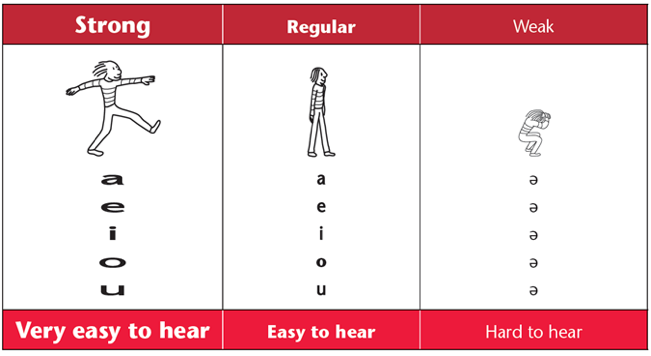
Fig. 4. The difference between stressed and de-stressed vowel sounds (Gilbert, 2012b, p. 38).
Task A. Ask students to write the words below. Then underline the letters of the stressed syllables and draw a slant line through the reduced vowels or have them draw a schwa symbol below the reduced vowels.
ketchup mustard vanilla tomato lettuce carrot
orange sandwich chicken breakfast muffin bacon
This can also be done with any other words you can think of.
Task B.Follow a similar pattern with the sentences below, especially noting how little words like “an” or “a” or “the” are made even smaller with a reduced vowel.
We need a comPUter. I want an ASpirin. This is a good arRANGEment.
4. The English spelling/sound connection is not like Spanish
First of all, students need to know that letters and sounds are different things. Then they need to be able to say the names of the English alphabet letters easily. This is worth spending serious time on, since the names of the vowel letters in the Spanish and English alphabets are so different in Spanish. In Spanish, each letter has one sound. On the other hand, in English, these letters are often said with two or even three different sounds. This is because there are two main types of English vowel sounds. It is true that there are other vowel sounds but these are the most common. The vowel types have traditionally been called long (aid, sheep, mice, hope, cute) and short (add, ship, miss, hop, cut). However, the use of these two terms can be a source of confusion when students are learning about the difference in length between stressed vowels and reduced vowels. So, instead of long and short, I prefer to call them alphabet vowel sounds and relative vowel sounds. These terms are less abstract and more familiar than terms like tense and lax.
5. Alphabet vowel sounds: The names of the letters
It is probably most practical to teach the alphabet vowel sounds first, because they are a natural part of teaching the names of the alphabet letters. These vowel sounds all have an extra little sound as the tongue moves up a bit. Below are pictures to show how the tongue moves to a secondary position. This is not like Spanish, but is necessary in English. It is one reason an English speaker sounds odd when speaking Spanish. For example, think of the difference between the Spanish word “de” and the English word “day”.
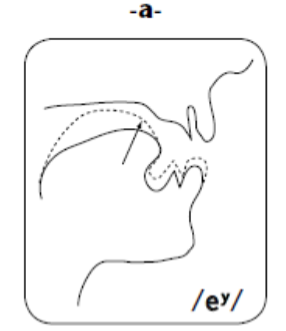
Fig. 5. Position of the tongue for /ey/sound (Gilbert 2012a, p. 10). .
Notice the little superscript yin the symbol /ey/. This is the mark of that extra little higher vowel sound at the end of the main vowel sound. The change upward of the tongue also makes a change of the lips upward. The following figure shows the position of the lips.
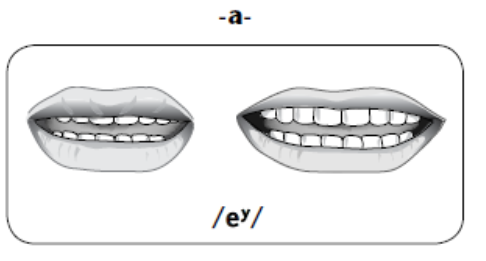
Fig. 6. Position of the lips for /ey/sound (Gilbert, 2012a, p. 11).
In a slow video of the lips of an English speaker saying “see”, the lips will change into a wide shape, ending with a smile position. But if a Spanish speaker is saying “sí” the lips will start from this smile position. Try slowly saying both “sí” and “see”. Do you feel a change in your tongue and your lips when you say the English word? Vowels that are said in the back of the mouth follow this same change of pitch pattern, only with a rounded shape of the lips instead of a smile. That is why the symbol for the vowel in “cone” in the key word list below has a little superscript w meaning a rounded position. Try saying “No” in English and then in Spanish. The Spanish version of the letter o does not have this change. Figure 7 displays the position of the lips.
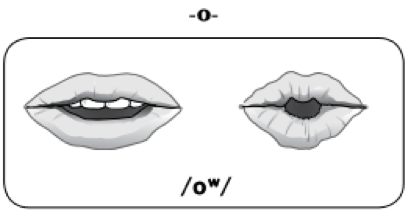
Fig. 7. Position of the lips for /ow/sound (Gilbert 2012a, p. 11).
Regarding the key alphabet sounds, I provide the following figure.

Fig. 8. Key alphabet sound words (Gilbert 2012a, p. 12).
Figure 9 shows a rule to explain when a vowel spelling is likely to be one of these alphabet vowel sounds. The rule does not always work, but it works often enough to be worth learning. [See Figure 15 which shows the percentage of time the two vowel rule is likely to work.]
.png)
Fig. 9. The two vowel rule (Gilbert, 2012a, p. 12).
Task A. Write the key words in Figure 8 on the board and have the students then say each word as you tap on it.
Task B. Do the same task with the following words:
white green time read page rule write note board
Task C. Ask students to each bring two or three single-syllable words to share on the board at the next class meeting. The class should judge if the words fit the two vowel rule. This homework task helps them notice words outside of the class.
6. Relative vowel sounds
Relative vowel sounds are related to the same vowel letters, but they do not sound the same as the alphabet vowels. Relative vowel sounds are very common in spoken English. But they sound even more different from Spanish vowels than the alphabet vowel sounds do. For that reason they tend to be more difficult to hear and to say than the alphabet vowel sounds. They are different in two ways: the sound is different and they do not have the extra little sound at the end which is necessary for the alphabet sounds. That is why there is no extra y or w in the phonetic symbols. Here is a list of key words for relative vowel sounds.

Fig. 10. Key words for relative vowel sounds (Gilbert, 2012a, p. 14).
Now we shall look at the one vowel rule and Figure 11 provides us the rule for relative vowel sounds. [See Figure 14 which shows the percentage of time the one vowel rule is likely to work.]

Fig. 11. The one vowel rule (Gilbert, 2012a, p. 14).
Task A. Write the key words from above on the board and tap teach word for the student to say.
Task B. Do the same task with the following classroom words:
black red class pen task desk clock
Task C. Ask students to each bring in two or three single-syllable words to share on the board at the next class meeting. The class should decide if the words fit the one vowel rule.
Task D.Write alphabet vowel sound and relative vowel sound on the board, and then say words such as:
hope/hop teen/ten cute/cut sheep/ship pain/pan
Ask the class to decide which column they belong to.
Multisyllable words
The two vowel rule also applies to words with more than one syllable. It should be practiced in the same way as with single syllable word. Figure 12 provides an explanation for the two vowel rule for a multi-syllabic word, such as absolute.

Fig. 12. The two vowel rule for multi-syllable words (Gilbert, 2012a, p. 20).
Task A.Follow the same tasks as for one syllable words, but using words such as:
remain repeat alive soapy Tuesday
erase season inside alone assume
parade reasonable treat provide suppose introduce
graceful agreement entirely approach useful
Task B. Make two columns on the board labeled “Alphabet Sounds” and “Relative Vowel Sounds.” Form students in teams and have them compete to think of multi-syllable words for each column. The team that comes up with the most words in correct columns in five minutes wins.
The one vowel rule also applies to words with more than one syllable. It should be practiced in the same way as with single syllable words. The figure below explains how the one vowel rule applies to a multi-syllabic word, like magnify and it also provides an activity for classwork.
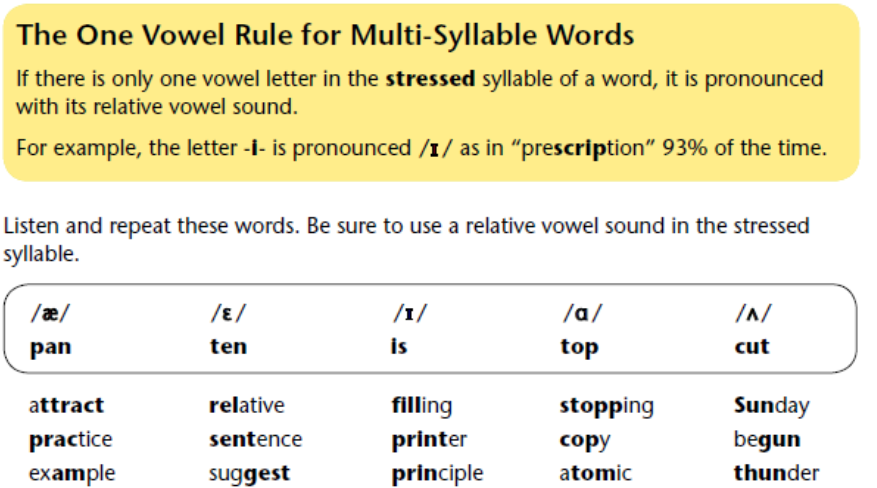
Fig. 13. The one vowel rule for multi-syllable words and an activity (Gilbert 2012a, p. 21).
8. Charts of the reliability of these rules
Concerning the reliability of these rules, I offer two figures which shows the percentage of time that the one vowel rule and the two vowel rule are applied. These statistics are taken from Edward Carney’s (1995) study of 25 million words in five independent American and British frequency counts. This information is important because it encourages students to believe that these spelling/sound rules are worth learning. Otherwise, it seems that English spelling is so chaotic that each new word must be memorized independently.

Fig. 14. How often does the one vowel rule work in stressed syllables? (Gilbert, 2012a, p. 144).
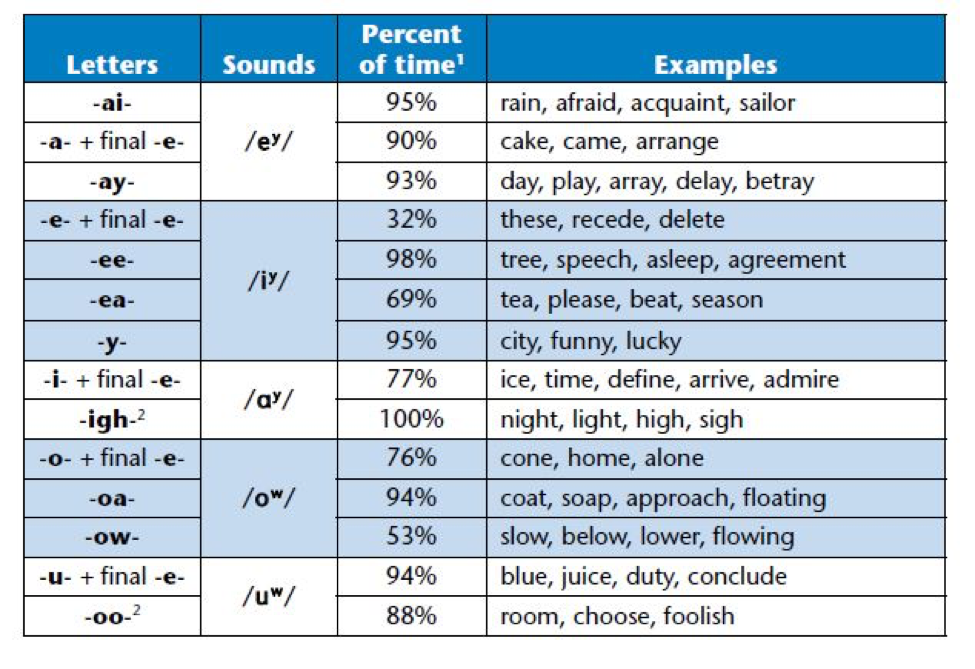
Fig. 15. How often does the two vowel rule work in stressed syllables? (Gilbert, 2012a, p. 144).
Conclusion
In order to know how to correctly pronounce English written words, it is necessary to understand the importance of the English prosody system. This system calls attention to which word is most important. The system means that the vowel in the most stressed syllable of the most important word (the peak of information) must have extra length. To make a good contrast, the vowels around it must be shortened. Contrastive length is why English rhythm is irregular. Contrastive clarity required by this system governs which vowel sounds should be clear and which should be unclear. For that reason, the learner needs to understand the reason for some vowels to be unclear (schwa) and which of the two main forms of clear vowels (alphabet, and relative) to use for the peak vowel. It is also necessary to understand how to know from the spelling which of the vowel sounds to use, depending on the spelling of the stressed syllable.
This article has provided helpful information for teachers who work with Spanish speaking students who are in the process of learning English in an EFL or ESL context. I have also offered classroom advice for helping learners not only to understand the system, but to practice the way the complexities of pronouncing printed English words are formed directly by the need to highlight emphasis. Often this interrelationship is overlooked, and I hope that this article has motivated the readers to address the English prosodic system in their classroom practice.
References
Carney, E. (1994). A survey of English spelling. London, UK: Routledge.
Chela de Rodriguez, B. (1991). Recognizing and producing English rhythmic patterns. n A. Brown (Ed.), Teaching English pronunciation: A book of readings. London, UK: Routledge.
Derwing, T. & Munro, M. (2005). Second language accent and pronunciation teaching: A research-based approach. TESOL Quarterly, 39(3), 379-397. doi: 10.2307/3588486
Gilbert, J. (2012 a). Clear speech (4th ed.). New York, NY: Cambridge University Press.
Gilbert, J. (2012 b). Clear speech from the start (2nd ed.). New York, NY: Cambridge University Press.
Hahn, L. (2004). Primary stress and intelligibility: Research to motivate the teaching of suprasegmentals. TESOL Quarterly, 38(2), 201-223. doi: 10.2307/3588378
Patel, A. D. (2008). Music, language, and the brain. Oxford, UK: Oxford University Press
Walker, R. (1999). Proclaimed and perceived wants and needs among Spanish teachers of English. Speak Out! Newsletter of IATEFL Pronunciation Special Interest Group, 24, 25-32.
Werker, J. F., & Gervain, J. (2013). Speech perception in infancy: A foundation for language acquisition. In P. Zelazo (Ed.), The Oxford handbook of developmental psychology (909-925). Oxford, UK: Oxford University Press.

